Pink Floyd
Albums
reviewed on this page: The
Piper at The Gates of Dawn, Relics,
A
Saucerful of
Secrets, Ummagumma, Atom Heart
Mother, Meddle,
Dark Side of
the Moon, Wish You Were Here,
Animals,
David Gilmour, The
Wall, The
Final Cut, About Face,
The
Pros & Cons of Hitch-Hiking
Few groups have changed to Pink
Floyd's extent. Originally a
psychedelic band built around the singular talent of guitarist and
songwriter Syd Barrett, their spectacular debut, The Piper at
the
Gates of Dawn is a strange mix of nursery rhymes, extended
exploratory instrumentals and pop music. Things
quickly
turned sour when Barrett burned out on LSD after a few experimental
singles, exiting to become a cult hero with a pair
of dysfunctionally brilliant albums. Floyd quickly
brought
in David Gilmour to supplement and then replace Barrett, and Gilmour
and bassist Roger Waters filled the resulting songwriting
gap.
During their next few albums the band continued exploring their
experimental side, which can be characterized as space-rock,
symphonic progressive rock, or just atmosphere. (This did
have
its downsides, as the studio half of Ummagumma is
experimentation gone awry.) Floyd had drifted into soundtrack
work early on (More and Obscured by Clouds),
and much
of their work has that approach - except that you sit back and let
your own mind produce the images. Long-form tracks like "Echoes"
and "Atom Heart Mother" were a natural outgrowth of this
experimentation, are the reason I think of the band as a gateway drug
to Krautrock. The band's other side emerged as a
sort of a
folky, pleasant (stoned) sound that was either be warm and inviting,
or the gasps of a broken man. Meddle was both of the band's
sides' peak, as Gilmour led the others through a set of both inviting
acoustic based music, and bizarre soundscapes. With Dark
Side of the Moon in 1973, two things happened - Waters
started
taking control of the group and focused the lyrics on album-length
stories (Animals, The Wall), and
the band's sound got
colder. Eventually, he kicked out keyboardist Rick Wright,
(who
returned as a session man), then dissolved the group after putting
out what was essentially a Waters solo album (The Final Cut).
Gilmour reformed the group with the other two members (Wright and
drummer Nick Mason) and they have since recorded and toured, with
little inspiration and huge success.
Pink Floyd is one of my favorite
groups, but I have to slag them
somewhat. First off, their rhythm section is a blase at
best.
Drummer Nick Mason is a nice fellow I'm sure, but he is effectively a
light jazz drummer who managed to do just enough to not sound
incompetent. Roger Waters has the excuse of singing, but his
bass work is unremarkable - any novice can play along with his parts
on The Wall for
example. Gilmour is the band's
post-Barrett lynchpin - he has a pretty distinct style, and manages
to work the same vaguely bluesy style into something new each time
around. I always feel that poor Wright gets unappreciated -
his
songs were always nice happy tunes, and they provided a nice contrast
to the rest of their material.
Just as a warning - this was one
of the first bands I reviewed, so
the writing may be coarse, the ratings too high, the opinions wrong
and the thoughts incoherent.
I have listed what I know of
their solo work, with Syd Barrett on
a separate page.
Personnel: Roger
"Syd" Barrett (guitar,
vocals); Roger Waters (bass, vocals); Rick
Wright
(keyboards, some vocals); Nick Mason
(drums). David
Gilmour (guitar, vocals) brought on to supplement Barrett
soon after Piper,
who then left. Wright kicked out in the late 70s?
Waters left after The Final
Cut, and I'm unsure of the band after that point.
Pink Floyd:
"Arnold Layne"
/ "Candy and a Current Bun"
(Mar. 1967)
They had been a R&B band, but their first single
is
emphatically psychedelic pop. The characteristics of the
Barrett
are all here: striking subject matter (a man stealing women's clothes
and getting imprisoned), Waters' vivid farfisa organ, an trippy
instrumental section instead of a real solo, fairly complex backing
vocals. It's not psychedelic pop in a Beatles' lighthearted
variety, however; Barrett's baritone sounds very serious, even if the
production isn't heavy. The b-side is like a Who R&B
song
gone psychedelic, with weirdness suchwith Barrett's low-spoken vocals
during the chorus and turns into a jam with the organ and a rudimentary
bass solo which sounds curtailed. Lots of echoes,
flashes
of noises, etc. Both produced by Joe Boyd, more famous for
working with folk groups like Fairport Convention. "Arnold
Layne"
is on compilations like Relics,
but "Candy and a Current Bun" is harder to track down (or it used to
be). It was a pretty good hit in the UK.
Pink Floyd:
"See Emily Play"
/ "Scarecrow"
(June 1967)
The quintessential Barrett psychedelic single.
Another
very pop single, even more complex, again with a Farfisa-led
instrumental section and Syd using a slide and lots of echo to give his
guitar parts a unique sound. The song is about either a child
playing, a romping drug user, or both. In contrast,
"Scarecrow"
starts out very sparse, with clacky percussion and Syd's guitar before
Wright's wondering Farfisa comes in to lead them. Again, it's
a
rather child-like subject, a portrait of a resigned scarecrow.
It's quieter (has some acoustic guitar) and a good compliment
to
the A-side. Pedantry: Norman Smith produced both tracks, and
"Scarecrow" appears on their album. "See Emily Play" was
later
re-mixed in stereo and usually appears on compliations in that mix.
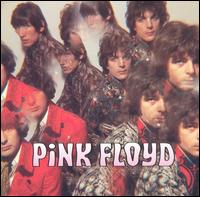 Pink
Floyd: The Piper at the Gates of Dawn (1967), ****1/2
Pink
Floyd: The Piper at the Gates of Dawn (1967), ****1/2
A
stunning array of LSD music, and its
power and vocal harmonies makes it quite different from
popular Floyd favorites. Along with Sgt. Pepper, Piper
at the Gates of Dawn defined the sound of psychedelia.
Using
then-new studio techniques and crisp production, Piper sounds
like nothing else from the era. Divided between attacking space
instrumentals ("Interstellar Overdrive" with the best intro
of any song, "Astronomy Domine") and lighter LSD-pop tunes
("Flaming", "The Gnome"), Barrett's songwriting
and guitar work propel this above other work from the period.
Even an experimental sound collage at the end of "Bike" is
kept within tasteful bounds. Waters' sole contribution, the
one-joke "Take up Thy Stethoscope and Walk", shows that he
had not found his niche yet. Wright occasionally swoops in to
deliver a solo ("Pow R. Toc H."), but stays more in the
background with his ominous organ. The only non-Waters song
that isn't quite up to par is the slower "Chapter 24", with
Barrett's lyrics taken from the I
Ching. Otherwise,
Piper is a
excellent mix of experimentalism and pop that may never be
matched.
Produced by Norman Smith.
Pink
Floyd: "Scream Thy Last
Scream" / "Vegetable
Man" (rec. Aug. 1967, unreleased)
The purported a-side is insanity. The b-side,
whose fidelity is far worse, is more along the lines of
just-not-making-sense.
Pink
Floyd: "Apples and Oranges"
/ "Paintbox"
(Nov. 1967)
The last overblown pop single with Syd. A dash
of madness, a dash of overproduction
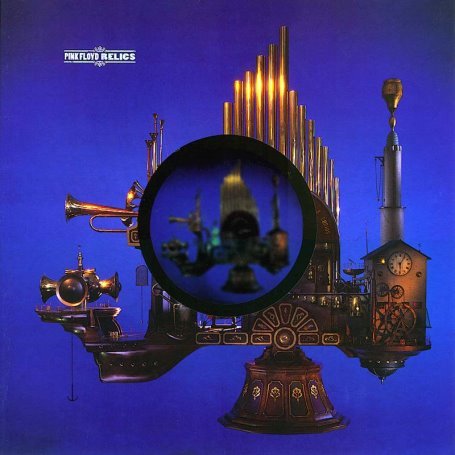 Pink
Floyd: Relics (rec. 1967-1968)
Pink
Floyd: Relics (rec. 1967-1968)
For
the legions of students who know only of Floyd's radio hits and
Waters' bitter explications of self-destruction and neuroses, it may
be shocking to learn that the band had a life before Dark Side of
the Moon. But even for those fans who accept and
enjoy the
band's psychedelic and atmospheric eras, it is easy to forget that
Pink Floyd was considered a pop band originally.
In fact, their first single, "Arnold Layne", made the Top
Twenty in the UK, and its follow-up "See Emily Play"
cracked the Top Ten, and both are fantastic psychedelic pop
tracks.
But after Piper
was released, the
band released three further singles, although I think only some parts
of them appear on this compilation. First came "Apples and
Oranges" and "Paintbox", the former being another
crazy Barrett piece, and the latter a jazzy little Wright piece
similar to the style he later used with "See-Saw".
They also recorded two other incredibly bizarre Barrett songs which
were not released at the time (and may never have been formally
released) - "Scream Thy Last Scream" and "Vegetable
Man", which are completely insane. I mean
people-eating-shoes nuts. After Barrett's
departure, the
band released a few more singles which are pretty interesting,
although the band has since disowned them. The next A-Side,
"It
Would Be So Nice", was a pretty complex Wright pop song, and the
flip, "Julia Dream", a relaxed acoustic ballad, probably by
Waters. Finally, their last attempt was "Point Me at the
Sky" - this one by Waters I think, and about a man and an
airplane I think. This was likely the source of the promo
photo
of the band dressed up as aviators in my A Saucerful of Secrets
CD. The back side was the original version of "Careful
With That Axe, Eugene" - the consummate bizarre jam later heard
on Ummagumma.
The main thing is that these were all for
the most part really good songs, and it's a shame that the band
sometimes acts like they never tried to try smiley psychedelic pop
without Syd Barrett. Most of these appear on Relics, but
not all, although I think they are worth tracking down.
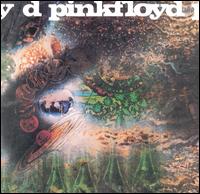 Pink
Floyd: A Saucerful of Secrets (Jun 1968), ***1/2
Pink
Floyd: A Saucerful of Secrets (Jun 1968), ***1/2
Barrett
was non-functional by this point, and he left the band early
on during the album's recording, and Waters and Wright stepped
forward to pick up the slack. The result is a transitional album --a
feel towards darker sounds, the extended mind-blown jams replaced by
more structured space-rock, and a strange mixture of psychedelia,
progressive rock, and stoner jam band. Waters' music is much
darker than Piper
ever was, relying on breathy vocals,
repeated bass riffs ("Set the Controls for the Heart of the
Sun", the main riff in "Let There Be More Light"
appears briefly in "Astronomy Domine") and lyrics that you
understand, but are still cryptic. Wright, on the other hand,
continued the band's psychedelic pop side with the dreamy "Remember
a Day" and the delightfully jazzy jewel of "See-Saw".
Waters makes one attempt a Barrett style psychedelic nonsense which
may appeal to you, the absurd character piece "Corporal
Clegg" with kazoo choruses. Gilmour had yet to develop his
sustain-heavy tone and he shares the stage with Wright for most of
the album in a sort of place-holding fashion ("Let There Be More
Light"). Barrett appears on two songs,
playing
the pingy slide leads to "Remember a Day" and contributing
his haunting "Jugband Blues", which is a bizarre
combination of schizophrenic lyrics and a Salvation Army band. Thus,
Wright's creepy background organ to set the mood ("Set the
Controls For the Heart of the Sun"), and the title track is a
long space-rock track that attempts to make do without Barrett's
guitar, and the wordless
vocals and organ line of the ending makes it curiously
similar to Procol Harum's
"In
Held Twas In I". Saucerful
is very inconsistent, but without the driving force that led both
"Astronome Domine" and "Instersteller Overdrive",
the band wisely changed to a more atmospheric sound, even if Wright
never got this much face-time ever again. Produced by
Norman Smith.
Pink
Floyd: More (1969)
The
soundtrack to an obscure French
film. Gilmour was now fully in the band, and sings all the
songs. Waters, of course, writes them (with an occasional
group
credit). I've heard this and the numbers that stick out are
the
soft "Green Is The Color" and "Cymbaline" with a
surprising scat vocal part. It seemed decent, yet
unremarkable.
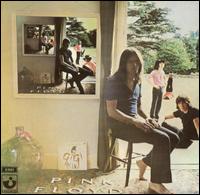 Pink
Floyd: Ummagumma (1969), ***
Pink
Floyd: Ummagumma (1969), ***
Wildly
uneven. A double album with one disc recorded live, and the other
containing studio attempts at avant-garde music by each member (it
could have been named Fun With Tape Effects). The live
disc covers their looser jam songs ("Astronomy Domine", "A
Saucerful of Secrets") and Wright's
organ and Gilmour's odd guitar sound make it sufficiently
creepy.
The studio disc is hit and miss. Waters' "Grantchester
Meadows" is a pleasant acoustic number, while his "Several
Species Of Small Furry Animals Gathered Together In a Cave and
Grooving With a Pict" is as bizarre as the title, with layered
noises and Waters reading incomprehensible poetry with
a bad Scottish accent. Wright's "Sysyphus"
starts out as a classical piano work and then disintegrates into
unlistenable nonsense. Wright's "The Grand Vizir's Garden
Party" is pretty much restricted to percussion, with a nice
flute intro and outro (continuing the trend of prog rock groups with
a flautist). Gilmour's contribution, "The Narrow Way",
is far superior (Parts 1 and 3 that is; Part 2 is whacko guitar
noise), foreshadowing both the multilayered guitar parts on Meddle
and the sustained sound of Dark
Side onwards. Produced by
Norman Smith.
Roger
Waters and Ron Geesin: Music from "The
Body" (1970)
An
obscure movie soundtrack, featuring tracks like "More than Seven
Dwarves in Penis Land". Yup.
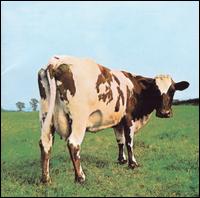 Pink
Floyd: Atom Heart Mother (1970), **
Pink
Floyd: Atom Heart Mother (1970), **
Uh
oh. British audience members must have really been buying any
orchestrated progressive rock they could get their hands on when they
pushed this to the top of the charts. The title track is a
suite which takes up the entire first side, and is almost strictly
instrumental. Given that Floyd's two main singers had rather
thin voices, hence their volume of soundtrack work, this is not a bad
idea. Floyd made it a bad idea by turning most of the track
over to arranger/director Ron Geesin who, by the sound of it, liked
horn sections and strange choral vocalizations. The band then
contributed a piddly "classical" section (Wright playing
single note triplets slowly), one average spacey blues jam and one
standard melody. If you are looking for a serious,
less-experimental work by the group, this is it. If you are
looking for something to hold your interest through repeated listens,
this is not it. The back side is home to tracks by all three
songwriters and then another suite. Waters wrote a piece of
acoustic filler ("If"), and Wright delivered a final
interesting piece of psych-pop ("Summer '68" - perhaps when
it was written?), leaving Gilmour to present the lone memorable song
-- the warm, laid-back "Fat Old Sun", featuring his
trademark lap steel guitar. The concluding suite, "Alan's
Psychedelic Breakfast", is instrumental filler around the sounds
of one of their roadies making breakfast. Yeah. It
is
pretty remarkable how little substance this album has, but those who
cannot get enough of Floyd's comfortable, enveloping sound will enjoy
it. Produced by the band.
Syd Barrett: The
Madcap Laughs (1970)
Syd Barrett: Barrett
(1970)
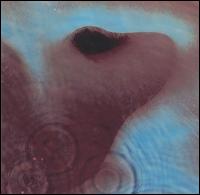 Pink
Floyd: Meddle (1971), ****
Pink
Floyd: Meddle (1971), ****
Meddle
shows Floyd at their
trippy best, as they avoid the pitfalls that befell them on Atom
Heart Mother. This is effectively the peak of
Gilmour's
influence within the band --Waters doesn't place one of his
depressed, mumbly hopeful ballads, and Wright's upbeat psychedelia
finally disappears amidst a mixture of relaxed rock and more
experimental instrumentals. "One of These Days" opens
the album with the thumping sound of two basses and the occasional
pounding of drums, before Gilmour's guitar arrives. It
appears
with a strange note bending intensity, and sounds like a
silver-plated chain saw in the hands of a maniac. Topped off
in
the middle with Nick Mason's only Floyd vocals ever (the distorted
"One of these days, I'm going to tear you into little pieces"),
the song is mania without being cacophony. Needless to say,
the
rest of Meddle
is different. The two best songs are
Gilmour/Waters collaborations: floating, dreamy folk ("A Pillow
of Winds" clinching Floyd's record for most songs featuring the
word "eiderdown"), and uplifting quiet rock ("Fearless").
Gilmour contributing most of the vocals, and often multiple guitar
parts. Some tracks smack of filler - "Seamus" is an
acoustic blues number with the titular dog howling along, and not
much else, while "San Tropez" is a rather unexpected light
jazz song (by Waters no less!), with a pleasant
feel. All
of these songs have a quiet warmth to them - the embers of a summer
fire.
Then you can turn your
gaze upward for "Echoes", which occupies the second half of
the album. This is the Requisite Long Piece, and the band had
wisely decided not to enlist the services of
orchestra.
Floyd gave their space-rock a shimmery tone, but continued on with
long sections of instrumentals and strange noises, getting
progressively more abstract. The piece opens with a
famous ping noise, which could be either a submarine, or contact with
alien life, more likely the latter given the alien soundscrapes that
mark the song. The opening chorus and verses have
the
dark jazz feel foreshadowing Dark
Side before shifting into a
blues jam where Gilmour gets to stretch out and slowly burn up his
guitar. If it sounds familiar, it should: they
tried the
same sort of thing in "Atom Heart Mother", but much slower
and it backfired. Then things get quintessentially creepy
...and well, unsettling, with Gilmour making noises, and the band
demonstrating their potent atmosphere skills, before returning again
to the chorus. Although it could be tightened up, they did
not
do anything silly like ask Wright to solo, and it is highly
effective. A success and a stepping stone. Produced by the
band.
Pink
Floyd: Obscured by Clouds (1972)
Another
movie soundtrack. I didn't find it terribly impressive when I
heard it.
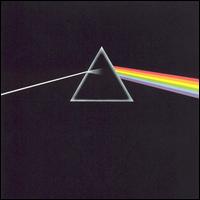 Pink
Floyd: Dark Side of the Moon (1973), *****
Pink
Floyd: Dark Side of the Moon (1973), *****
[to be re-written]
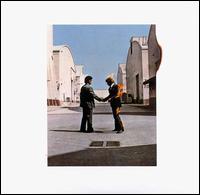 Pink
Floyd: Wish You Were Here (1975), ****
Pink
Floyd: Wish You Were Here (1975), ****
[Ed. This is slighly more coherent, but
still bad.]
A worthy follower to
Dark Side,
if not quite as good. Again, a concept album,
this one focusing of the music industry and to some extent, Syd
Barrett. "Shine On You Crazy Diamond", an intro
and outro which takes up close to 25 minutes, is a
lengthy jam focusing mainly on Gilmour (Wright to a lesser extent),
and changes enough to maintain the listerner's interest.
"Welcome to the Machine" builds on the heavily synthed
sound of Dark Side of
the Moon, yet annoys. "Have a
Cigar", with vocals by Roy Harper, is also not terribly good.
Except for that and the title track, Waters sings all the songs, in
addition to having written them. The deficiencies are made up
for, and then some, by the title track; a beautiful acoustic number
that undoubtedly is Gilmour's best melody, and should have been a
single.
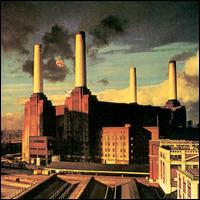 Pink
Floyd: Animals (1977), **1/2
Pink
Floyd: Animals (1977), **1/2
It
had been two years since Wish
You Were Here, and Floyd had not
progressed an inch musically, although Waters' bitterness
swelled.
Inspired by George Orwell's cunning satire Animal
Farm, Animals desperately needed a good editor.
Waters worked up his bitterness, turning on society in general,
rather than just the music industry. Some tracks feel like a
just a setting for him to spew sarcastic black bile ("Dogs"
is delightfully nasty), or for Gilmour to solo. Animals'
songs sprawl, with occasional salvage attempts (Gilmour's ending to
"Sheep" is a great chord
progression). The good old Pink Floyd sound is there, but
there
are too many sections of dead air. For
example, "Dogs" collapses when the sound is
given over to Wright's synthesizers or dog noises. Both that
track with its jazzy chord progression and "Pigs (Three
Different Ones)" could be good songs, but they stall out in the
middle in atmospheric sections. The Mountain-like
beat on "Pigs (Three Different Ones)" is
unusual, but Waters just appropriated it to mock bloated society
figures (much like your seventies hard rockers?).
The
remaining songs, both parts of "Pig on the Wing", are
archetypal glum, romantic Waters acoustic filler. Waters also
gets penalized for overdubbing animal noises to some of the tracks,
and making the not-so-stunning analogy between sheep and organized
religion. The only minor cool thing are recordings of dogs
barking, modified to be on frequency (or at least a synthesized
sound-alike). A lesser, embittered Wish You Were, and
one that needs the sort of trimming the The Wall would
later
have.
 David
Gilmour (1978), ****
David
Gilmour (1978), ****
This
is one of the most relaxing albums I own. Gilmour's solo
debut
sounds similar in some ways to his songs on Meddle (slower,
lots of overdubbed guitar), and is fairly distant from the sound Pink
Floyd would make with The
Wall. About a third of the
songs are instrumentals, and they tend to repeat themselves and drag
some ("Mihalis, "Raise My Rent"). The rest are
good, especially the soaring "There's No Way Out of Here"
with female backup vocals, and the piano-driven "So Far Away"
(with piano courtesy of Mick Weaver). Gilmour handles
keyboards
as well as his usual guitar and vocals, and his backing band of Rick
Wills on bass and Willie Wilson on drums constitutes
a reunion of his pre-Floyd outfit, The Jokers' Wilde.
Self-produced.
Richard
Wright: Wet Dream (1978)
I
have this. I found it boring when I listened to it maybe 8
years ago.
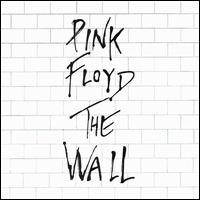 Pink
Floyd: The Wall (1979), ****1/2
Pink
Floyd: The Wall (1979), ****1/2
[also to be re-written] Not
only a concept album, but a double concept album about a rock
star who can't cope with the pressure. As had become the
norm,
Waters writes and sings just about everything. The Wall is more
coherent than Floyd's previous attempts at concept albums, as Waters
made the lyrics and not the music as the unifying
force.
In that sense The Wall
focuses a greater variety of musical
styles than they had for some time - acoustic ("Mother"),
synth-heavy ("Empty Spaces"), hard rock ("Comfortably
Numb"), piano and vocals ("Nobody Home"), patriotic
anthems ("Bring the Boys Back Home"), even the Beach Boys
("The Show Must Go On"), culminating in the orchestrated
trial sequence at the end. Water's bass lines are simple and
reverb-heavy ("Brick In the Wall"), Mason's playing is at a
minimum, with Gilmour the only one in top form. But it is
well
conceived and executed, with only a few slow moments.
Nick
Mason's Fictitious Sports (1981)
Avant-garde
jazz work, and Mason's more a participant than a leader. Robert
Wyatt provides some vocals.
 Pink
Floyd: The Final Cut (1983), **
Pink
Floyd: The Final Cut (1983), **
Listless. Every
song crawls along, making the album deadly boring. Gilmour's
guitar is sparsely used, with the definite focus being on Waters'
album-long lecture on war and its evils. Out of the few
energetic songs, the thumping "Not Now John" sounds like
Waters' subsequent solo work (it also has background singers saying
"F*** all that"), "Hero's Return" is a good
attempt, but only "Gunners Dream" rises above the
substantial mediocrity of the album. The National Philharmonic plays
throughout, conducted by Michael Kamen, Wright does not seem to
appear, with Andy Bown (organ) and Kamen (piano) picking it
up.
In addition to Mason, Andy Newmark is credited on drums, and Ray
Cooper is on percussion. Finally, Raphael Ravenscroft
delivers
some Dick Perry-esque sax for "Gunners Dream". If
"Not Now John" was not the second to last track I'd
recommend it or insomniacs. Produced by Waters, Kamen and
James
Guthrie.
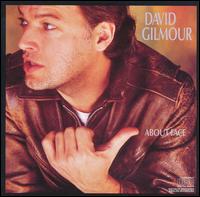 David
Gilmour: About Face (1984), ***
David
Gilmour: About Face (1984), ***
An attempt to update Gilmour's sound with a slick 80s
backing
group and a de-emphasis on his guitar virtuosity. Not that it
makes much difference, as Gilmour's writing was going through a
semi-dry spell. But Pete
Townshend
donated a few songs (including the good-timey "Love On The Air")
and Gilmour dishes up a few sparks of brilliance like the shifting
"Murder". Not to mention the wonderful "Out of
the Blue" with piano and faint orchestral backing. The
rest is pleasant filler, with only one instrumental (the low-energy
"Let's Get Metaphysical"), and the worst being the
dance-beat "Blue Light" with horns. The rhythm
section was Jeff Porcano (drums) and Pino Palladino (bass) with Ian
Kewley on keyboards. Elsewhere, Steve
Winwood, Ry Cooper and Jon
Lord are
around. Produced by Gilmour and Bob Ezrin.
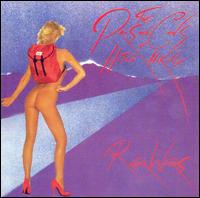 Roger
Waters: The Pros & Cons of Hitch-Hiking (1984),
**
Roger
Waters: The Pros & Cons of Hitch-Hiking (1984),
**
What
a surprise: another concept album from Roger Waters. How to
make Hitch-Hiking:
take The Wall,
cut in half, use the same theme for over half of the album, have
Waters sing less and speak more, and replace the lyrics with even
denser ones. This time around Waters can't come up with a
catchy tune at all (he goes so far as to partially recycle "Mother")
and so eveything sounds the same. He doesn't give you a place
to grasp onto until over halfway through (the duet "For The
First Time Today-Part 1"), and even slips into a decent dance
beat (title track, with a spoken line from actor Jack Palance),
before returning to that darn theme again. His vocals seem to
fluctuate wildly between breathy spoken word and shouting, with
little actual singing. As for the lyrics, they work better as
poetry than in a song, and focus to a lesser extent the same issues
that seemed to plague Waters' psyche in The Wall (his wife,
suicide, etc.). Even Eric
Clapton, try as he may ("Sexual
Revolution") can't save the album. The rest of the band
has some of the same players as The
Final Cut: Andy Bown
(organ, guitar), Michael Kamen (piano), Andy Newmark (drums), David
Sanborn (sax), Ray Cooper (percussion), and additional female backup
vocalists, horns, and the National Philharmonic Orchestra replacing
synths. Produced by Waters and Kamen.
Pink Floyd: A
Momentary Lapse of Reason (1987)
Roger Waters: Radio
K.A.O.S. (1987)
Pink
Floyd: Delicate Sound of
Thunder (1988)
Live.
Roger
Waters: The Wall in Berlin
(1990)
A
live album.
Roger Waters: Amused
to Death (1992)
Pink Floyd: The
Division Bell (1994)
Pink
Floyd: Pulse (1995)
A
double live album.
Pink
Floyd: Is There Anybody Out
There? (rec. 1980-1, rel. 2000)
2
CD live show of The Wall.
If you (don't)
think that this looks good, then I guess you should ...return to the
Music page.
 Pink
Floyd: The Piper at the Gates of Dawn (1967), ****1/2
Pink
Floyd: The Piper at the Gates of Dawn (1967), ****1/2  Pink
Floyd: Relics (rec. 1967-1968)
Pink
Floyd: Relics (rec. 1967-1968) Pink
Floyd: A Saucerful of Secrets (Jun 1968), ***1/2
Pink
Floyd: A Saucerful of Secrets (Jun 1968), ***1/2
 Pink
Floyd: Ummagumma (1969), ***
Pink
Floyd: Ummagumma (1969), ***
 Pink
Floyd: Atom Heart Mother (1970), **
Pink
Floyd: Atom Heart Mother (1970), **
 Pink
Floyd: Meddle (1971), ****
Pink
Floyd: Meddle (1971), ****
 Pink
Floyd: Dark Side of the Moon (1973), *****
Pink
Floyd: Dark Side of the Moon (1973), *****
 Pink
Floyd: Wish You Were Here (1975), ****
Pink
Floyd: Wish You Were Here (1975), ****
 Pink
Floyd: Animals (1977), **1/2
Pink
Floyd: Animals (1977), **1/2
 David
Gilmour (1978), ****
David
Gilmour (1978), ****
 Pink
Floyd: The Wall (1979), ****1/2
Pink
Floyd: The Wall (1979), ****1/2
 Pink
Floyd: The Final Cut (1983), **
Pink
Floyd: The Final Cut (1983), **
 David
Gilmour: About Face (1984), ***
David
Gilmour: About Face (1984), ***
 Roger
Waters: The Pros & Cons of Hitch-Hiking (1984),
**
Roger
Waters: The Pros & Cons of Hitch-Hiking (1984),
**